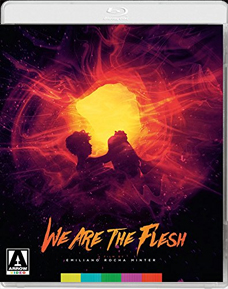 WE
ARE THE FLESH (2016) Blu-ray
WE
ARE THE FLESH (2016) Blu-rayDirector: Emiliano Rocha Minter
Arrow Video USA
 WE
ARE THE FLESH (2016) Blu-ray
WE
ARE THE FLESH (2016) Blu-rayArrow Video USA brings the Jodorowskian Mexican arthouse shocker WE ARE THE FLESH to Blu-ray and DVD.

Scrounging around a derelict industrial building, teenage siblings Lucio (Diego Gamaliel) and Fauna (María Evoli) scrounge a come across troll-like hermit Mariano (Noé Hernández, SIN NOMBRE) who trades gasoline for food. Mariano has embraced his own inner darkness in search of what lies on the other side of the void, and he nudges the siblings in the same direction by way of encouraging incest, blood drinking, and cannibalism. He secures Lucio's obedience and loyalty by poisoning and then curing Fauna, and Fauna's utter devotion through sexually exhausting himself to the point of death with her and then later resurrecting. In the interim, brother and sister push themselves to sexual extremes and take the blood of innocent victims before Mariano returns for an all-out orgy of blood and sex.
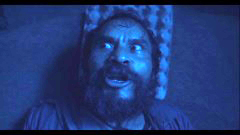 A
Jodorowskian journey beyond the void, WE ARE THE FLESH has its moments of utter
pretentiousness when Hernández is not dominating the screen with his
hissing voice and mad stare (Gamaliel and Evoli are less interesting for all
they are willing to bare onscreen as objects in the frame who do not hold the
gaze of the camera like Hernández's antihero). The film's Sadean philosophy,
construction of the womb-like cave out of planks, duct tape, and papier mache,
and bloody, naked writing will probably be sufficiently entertaining for fans
of extreme cinema who may have a harder time reconciling the film's country-specific
jabs at nationalism and religion. The more jaded viewer will see it as a lot
of decorative sound and fury, but the film cannot be entirely dismissed simply
for the subjective opinion that is not as extreme and transgressive as it aspires
to be.
A
Jodorowskian journey beyond the void, WE ARE THE FLESH has its moments of utter
pretentiousness when Hernández is not dominating the screen with his
hissing voice and mad stare (Gamaliel and Evoli are less interesting for all
they are willing to bare onscreen as objects in the frame who do not hold the
gaze of the camera like Hernández's antihero). The film's Sadean philosophy,
construction of the womb-like cave out of planks, duct tape, and papier mache,
and bloody, naked writing will probably be sufficiently entertaining for fans
of extreme cinema who may have a harder time reconciling the film's country-specific
jabs at nationalism and religion. The more jaded viewer will see it as a lot
of decorative sound and fury, but the film cannot be entirely dismissed simply
for the subjective opinion that is not as extreme and transgressive as it aspires
to be.
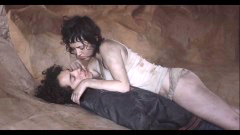
Arrow afford this feature – lensed with the Red Epic apart from some thermal imaging – their usual high bitrate treatment with a 1080p24 MPEG-4 AVC widescreen encode framed for much of the feature at around 1.90:1 or thereabouts (some scenes are pillarboxed 1.33:1 and others are a bit wider at 2.35:1). The HD image reveals in gritty textures and sweaty flesh for much of the film with later scenes drenched in candy colored gel lighting and digitally-graded colors. The original 5.1 mix is offered in DTS-HD Master Audio and an LCPM 2.0 downmix, both of which emphasize the sharp pitch of character voices, screams, shrieks, cries, as well as fleshy and squishy sounds, and the film's sparse scoring. Optional English subtitles are provided for the dialogue and some of the source music lyrics.
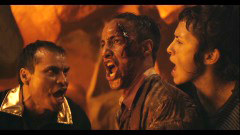 Two
short films from Minter are included with some thematic relation. "Dentro"
(12:39) details another strange construction: here a sort of nest-like basket
out of wood, vines, and rope that is employed to different use than the feature's
papier mache cave. "Videohome" (10:55) seems to examine the ways in
which a number of characters' embrace of solitude allows them to engage in odd
and abstract acts of a sexualized nature. Also carried over from other editions
of the film are a series of video interviews. Director Minter (18:20) starts
out a bit obnoxiously discussing how the script and the film just came together
magically as he wrote with no end goal in mind, but the discussion gets more
interesting as he discusses his influences including Georges Bataille (THE STORY
OF THE EYE) and the films of Mexican comedian Cantinflas. Hernández (20:20)
admits to not initially understanding the script but felt a connection between
Mariano and his own "malicious side" while Ivoli (13:09) – in
an English-language interview – identified with the fearlessness and uninhibited
nature of Fauna, and Gamaliel (13:30) recalls the exercises the director undertook
with the actors.
Two
short films from Minter are included with some thematic relation. "Dentro"
(12:39) details another strange construction: here a sort of nest-like basket
out of wood, vines, and rope that is employed to different use than the feature's
papier mache cave. "Videohome" (10:55) seems to examine the ways in
which a number of characters' embrace of solitude allows them to engage in odd
and abstract acts of a sexualized nature. Also carried over from other editions
of the film are a series of video interviews. Director Minter (18:20) starts
out a bit obnoxiously discussing how the script and the film just came together
magically as he wrote with no end goal in mind, but the discussion gets more
interesting as he discusses his influences including Georges Bataille (THE STORY
OF THE EYE) and the films of Mexican comedian Cantinflas. Hernández (20:20)
admits to not initially understanding the script but felt a connection between
Mariano and his own "malicious side" while Ivoli (13:09) – in
an English-language interview – identified with the fearlessness and uninhibited
nature of Fauna, and Gamaliel (13:30) recalls the exercises the director undertook
with the actors.
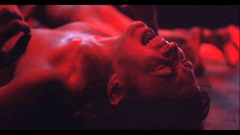 For
those quite ready to dismiss the feature as a pretentious mess, the Arrow-exclusive
"Virginie Salévy on WE ARE THE FLESH" (36:21) video essay provides
some thought-provoking contextual arguments about the film's borrowings from
Sade as well as Artaud's Theatre of Cruelty and Jodorowsky, the creation of
a dream space parallel to and simultaneously withdrawn from modern society,
as well as the ways in which the film subverts some of the elements of other
films that inhabit places in which taboos and conventional morals are overturned.
Also included is a behind the scenes stills gallery and trailer (1:29). Not
included for review were the reversible sleeve featuring original and newly
commissioned artwork, and the first pressing-only illustrated collector s booklet
featuring new writing on the film by critic Anton Bitel and a note from the
producer on the film. Unlike many of Arrow's other releases, the Blu-ray and
DVD editions are separate in both territories.
(Eric Cotenas)
For
those quite ready to dismiss the feature as a pretentious mess, the Arrow-exclusive
"Virginie Salévy on WE ARE THE FLESH" (36:21) video essay provides
some thought-provoking contextual arguments about the film's borrowings from
Sade as well as Artaud's Theatre of Cruelty and Jodorowsky, the creation of
a dream space parallel to and simultaneously withdrawn from modern society,
as well as the ways in which the film subverts some of the elements of other
films that inhabit places in which taboos and conventional morals are overturned.
Also included is a behind the scenes stills gallery and trailer (1:29). Not
included for review were the reversible sleeve featuring original and newly
commissioned artwork, and the first pressing-only illustrated collector s booklet
featuring new writing on the film by critic Anton Bitel and a note from the
producer on the film. Unlike many of Arrow's other releases, the Blu-ray and
DVD editions are separate in both territories.
(Eric Cotenas)